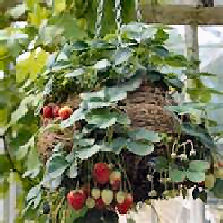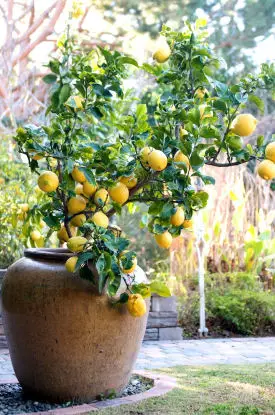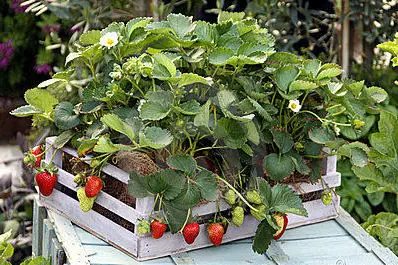Growing Fruit in Containers
Growing fruit in containers adds another dimension of edible gardening to your outdoor farming efforts. Many varieties of fruit trees for containers are available, and berries are easy to grow in pots or hanging baskets.
Fruit Trees
When growing fruit in containers, select varieties that are best suited to your climate. Dwarf fruit trees are ideal for container gardening. Choosing dwarf varieties makes it easier to prune and maintain, and you wont need a ladder when it's time to harvest.
Nearly all standard fruit trees come in dwarf forms that produce full size crops, including apple, apricot, cherry, nectarine, peach, pear and plum. Dwarf citrus trees, including orange, lemon, lime and kumquat are excellent candidates for container growing. In northern climates, they thrive outdoors all summer and then winter nicely in a sunny window.
Some species are self-pollinating while others require that you have a second tree. Before buying, check with an expert at your nursery to assist you in selecting the right tree. Bearing fruit may occur the first year but it may take until the second year for the tree to fully establish itself.
A simple way to tell whether a tree was properly maintained at the garden center is to check the height of the potting soil. It should reach within an inch of the container’s rim and feel moist to the touch.
The container
If you are growing fruit in containers, and are selecting fruit trees in particular, keep in mind what the mature height of the tree will be. Dwarf fruit varieties range in size from 2 to 7 feet tall. Choose a container that is several inches bigger in diameter than the nursery pot to allow for growth.
Any container material is fine. If you are gardening on a balcony, or want to be able to move the container, choose light materials like plastic or fiberglass. A tree in a container with soil and water can be heavy so only use wood or clay containers if weight is not an issue.
Planting
- Add a layer of gravel or small rocks to the bottom of the
container to help with the draining process.
- Use a good mixture of fertilizer
and nutrient rich soil that will drain well and place the tree inside the
container, spreading the roots into the soil.
- Cover the roots with soil, water, and continue adding soil until the container is well packed.
- Plant bare-root saplings that you have ordered or purchased at a nursery as soon as possible. If you can't plant immediately, wrap the roots and keep them moist so they don't dry out.
- Plant fruit saplings in early spring. Place them where they will receive plenty of sunlight but are protected from wind. ·
- Water well, but not to the point where water stands inside the container. This causes root rot.
- You may need to secure the tree with a stake until it becomes established.
Maintenance
- Protect the container from the elements. During the cold winter months, if
possible, bring the trees inside to keep the roots from freezing. Water to keep
the roots moist.
- Feed your fruit trees at least once every 6 months or use time-released feeding pellets.
- Transplant every 1 to 2 years to make sure the root system keeps having room to expand.
- Prune the top of the tree and its roots every 1-2 years (during the dormant period) to control the size and shape of the plant.
- Remove any unhealthy or damaged branches.
- Check for pest or parasites on a regular basis. Apply the proper repellent or insecticide as needed.
Berries
Strawberries - wait for temps to reach 55 to 60 before planting.
Use a 3 gallon container with equal parts organic compost and potting soil. Add granular fertilizer as directed on package.
Plant one plant per 3 gallon container. In a large container, plant one every 15 inches.
Strawberries need air, space and sun. Don't crowd them too much with other containers or plants. Plant seedlings in holes as deep as the root ball. Keep the plant level with the soil.
When watering,fill up the container and let the water soak through the soil. Strawberries need about 2 inches of water per week.

Blueberries - dwarf blueberry varieties are well-suited for containers.
Use potting soil formulated for azaleas or rhododendrons.
Fill the container to within 3 or 4 inches from the top and then add a couple of inches of mulch. Don't pack soil or mulch direct around the main stem of the plant.
Keep soil moist, but not wet. Fertilize about every 4 weeks during the growing season with fertilizer formulated for acid loving plants like azaleas or rhododendrons.

When growing fruit in containers, most gardeners will choose pots or boxes. Berries grow fine in those, but vining types do great in hanging baskets - they look nice too and don't take up floor space.
Return from Growing Fruit in Containers to Edible Gardening
Return Home enjoycontainergardening.com
Gardening Resources
Click the link below to visit my aStore @ Amazon -
Books & How To Help
Garden Tools & Supplies
Online Plants





New! Comments
Please leave me a comment and let me know if you like what you see here and if the information is helpful. Thanks.